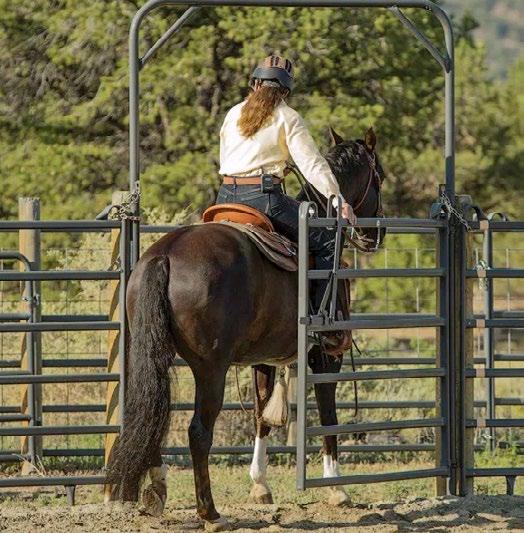
4 minute read
BRISTER’S BRIEF
BRISTER’S BRIEF
Gate crashing 101
Not just a time-saver, but also a test of your horse’s willingness to comply with your leg aids, learning to open gates while mounted can take both patience and practice, writes CHARLIE BRISTER.
Some people say: “If you can’t open the gate from horseback you don’t deserve to go through it.” That’s a bit rough, especially as there are situations where it’s only safe or practical to open the gate from the ground.
Opening gates while mounted saves time and is an excellent and simple test of a horse’s ride-ability. It is such an important safety and obedience test that opening gates is also a key movement in working equitation tests.
OK – it might be even quicker and simpler to jump the gate, but that won’t be a safe option for many readers.
So let’s get our horse ready, gear up with your gloves and helmet, perhaps have a dressage whip to help teach the leg yield movement, and then find the best swinging gate in your area.
Establish ground relaxation
Before you can perform this movement I suggest you establish what you want on the ground first. It’s safe, easy and effective training and will also give you an understanding of any issues you may have when you mount.
Stand with your horse. Check they can move forward, back and sideways off bit pressure or halter and gentle use of your whip. If they can’t do this from the ground, don’t bother trying to do this mounted as you need to establish these basics first.
If all is ok, introduce the gate to the horse and make sure they are relaxed with its movement, noise, and with walking through it. If not, reintroduce the gate daily until it becomes a nonissue and they are relaxed. They need to stand next to the gate and yield from both sides and then open and shut the gate. from the ground, it’s time to mount the horse.
Leg yield and halt
Can you leg yield your horse mounted? If not, this is a skill and exercise you need to master to open a gate safely. (For the many of us who are not dressage divas, leg yielding requires your horse to move sideways from your leg.)
Next, walk to the gate and along the fence line as close as possible and parallel to the gate. Repeat this until the horse is relaxed.
Then slowly ask the horse to stand closer to the gate by using a leg yield as required. The horse should be able to stand alongside the gate with the latch by the shoulder.
Sometimes a horse will squash the rider up against the gate, so you will need to also be able to leg yield away from the gate. Just work on your leg yield with the aim of getting a good, calm halt in the best spot without any fidgeting.
Don’t panic if the horse doesn’t halt in the ideal position first, just do a small circle and try to leg yield again.
Sometimes people open gates fronton with the horse’s head over the gate and the rider leaning over its shoulder. Reins and other gear can easily get caught in the gate if you and the horse are hanging over it. Please stay safe and develop the side-on technique.
One handed latching
When you and the horse are both standing side on to the gate latch and are relaxed, take both reins and whip in the hand furthest from the gate. Use your free hand to undo the latch. If the horse gets tense from the latch rattling, sit back in the saddle, relax, and try again. If all OK, swing the gate open.
If the gate can open both ways the safest method is to push the gate away from you. If you need to pull the gate towards you, you will have to get the horse to leg yield away from the gate.

A B


C D

Your horse should stand alongside the gate with the latch by their shoulder. B: If at any stage you find yourself sitting on the gate, something’s gone wrong! C: If the gate opens both ways, push the gate away from you. D: Don’t let the horse go through the gate until it is open fully and you’ve given the forward aid.
opening until it is open fully and you give the forward aid. Before you proceed through make sure there is nothing that will catch the horse, the rider or your tack. Too often a horse will whip through the opening and catch rider and gear on the posts. That is a very dangerous habit. the property which has a good footing and swings easily. You want the first gate they master to be a positive experience so that when you need to tackle the rusty gate that is rarely opened you will both handle it with ease.
It’s also the best way to practise leg yielding every day - it will help get you out of many tight spots on the riding journey!
Charlie Brister of Brister Equestrian is an all-round horseman based in western Sydney. His expertise is in re-training problem horses, as well as coaching riders in the art of cross country, show jumping and dressage. SEPTEMBER 2019 - HORSEVIBES MAGAZINE 7










